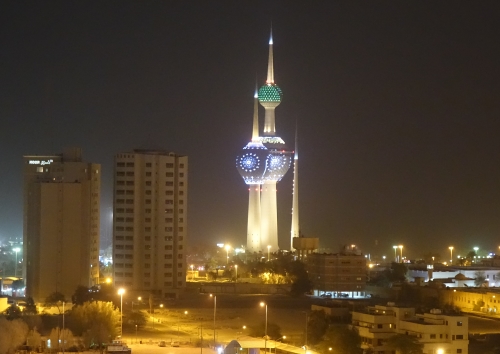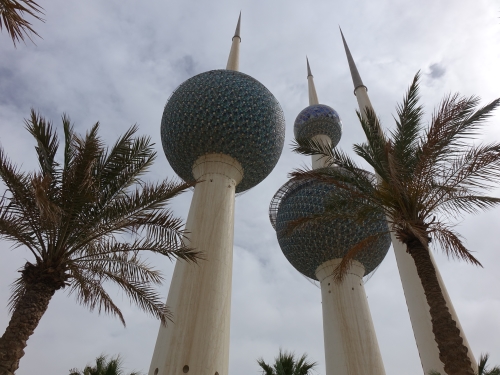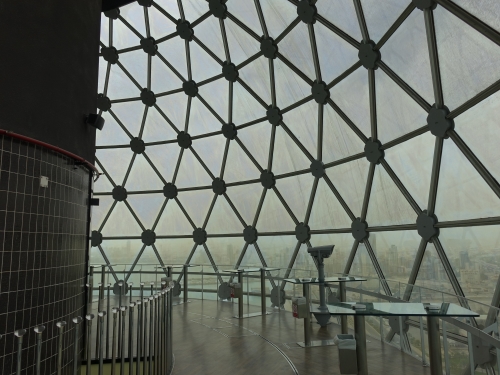Blog TWHS Visits
Kuwait Towers
The Kuwait Towers (Abraj Al-Kuwait in Arabic) is the most promising entry on Kuwait’s Tentative List. A visit is a great excuse to immerse yourself in the recent history of Kuwait. Next to the brash United Arab Emirates and Qatar, Kuwait is often overlooked. But economically it has bounced back nicely after recovering from the Iraqi occupation during the Gulf War (1990-1991). It has the fourth highest per capita income in the world according to the World Bank, and it is considered the region’s shining example on liberal achievements such as press freedom and gender equality.

The Towers are conveniently located in the heart of Kuwait City. They store water that is pumped from seawater distillation plants, and thus represent the network of modern water distribution among the population. The 3 that are known as the Kuwait Towers are the showpieces among the 34 water towers from the 1970s that lie scattered around Kuwait. Ironically only 1.5 out of these 3 provide the core function of storing water (the second one holds a viewing tower cum restaurant on top of the water reservoir and the third one only is there to illuminate the other two and for decoration I guess!).
The Kuwait Towers were damaged for 75% during the Iraqi occupation, but as the object of national identity they were rebuilt quickly and reopened in 1992. They date from the period that Kuwait enjoyed such a great oil-driven prosperity that it was equalled by few if any country around the world. Even I still remember reading in a magazine at school about all the free healthcare, education and money handouts the Kuwaiti citizens received. Oil still accounts for 90% of the government income. The current energy transition makes one think about which way a country like Kuwait is heading though.

After arriving in Kuwait late in the evening, I was pleased to have a very fine view of the illuminated towers from my 11th floor hotel room. They lighted up like Christmas ornaments, glittering and changing colours all the time. The colours used may also change for special occasions, as Martina & Ivan recently shot the Towers illuminated in the colours of the Kuwaiti national flag.
The next morning I walked towards them along the seafront. Kuwait City is surprisingly walkable, thanks to the wide pavements and low traffic. Up and close the towers proved to be attractive as well. I went up to the viewing platform of one of them (for 3 KWD – 8.3 EUR), from where you can have a look at the city through windows dusted with sand. There’s no attempt at interpretation about what the value of these Towers is – surely there would be room in one of them for a small exhibition? They’re an icon for sure, but also a bit of an empty shell.

I had the Kuwait Towers written down for nomination in 2019, but there is no clear info available whether Kuwait is really preparing a dossier. The latest news in this regard dates from January 2017 and indicates a visit by ICOMOS. Any future WH nomination of the Kuwait Towers will probably emphasize its “creative contribution to 20th century architecture”. It already received the Aga Khan Prize for Islamic Architecture, and comparisons are made with the Sydney Opera House. I would find it a pity though when its role in water management would not be acknowledged. Therefore I would like to see the other 31 towers also included in this nomination. While driving towards Kuwait City from the airport you can see another cluster of them to your right. These ones are striped and mushroom shaped, constructed to provide shade to the areas underneath.
Els - 31 March 2017
Comments
Solivagant 1 April 2018
"probably difficult to wash because of the odd shape"
No - the upper sphere with the viewing platform has an external cradle which can travel around and up and down the sphere for cleaning and repair purposes - it is clearly visible in some of my photos according to direction taken. One wouldn't expect anything less from Swedish engineers!
Els Slots 1 April 2018
Thanks for the link to the video, Solivagant. No, it certainly does not look like that. Although I have not been to the restaurant, maybe that is nicer than the viewing platform. I also like that the windows are really clean in the video, while in reality they are dusted with sand and probably difficult to wash because of the odd shape.
Solivagant 1 April 2018
We visited the towers way back in 2005 so they may well have undergone further “improvement” as a visitor experience etc since then – but your description above would seem to indicate that they are probably still much as they then were. I have come across a couple of links which would indicate that a major “enhancement” to the interior and surroundings has been “recently” planned. Unfortunately neither of them includes a date. However, the fact that the representations are all CGI would seem to indicate that they are still “in the future”. (???)
It appears that the Swedish engineering consultancy company Sweco (“active in the fields of construction, architecture and environmental engineering” - Wiki) was retained to “to investigate a design proposal for the reinvigoration of the Kuwait Tower. The purpose is to examine and redesign all services and functions of the Kuwait Tower and upgrade this landmark to the most modern standard while respecting its historic significance.” An interesting aspect of this is that the company which actually designed and built the towers (and the entire Kuwaiti water system of which they are a part) between 1965 and 1977 was VBB - the predecessor company to Sweco.
Sweco wouldn’t appear to be the sort of company which allows “old” material to remain on its Web site and this (apparently) current page titled “Kuwait tower reaching new heights” gives an indication of the sorts of things which emerged. Nb the reference to “During the development of the three proposals, Sweco has paid close attention to the potential UNESCO World Heritage Site classification”. No indication is given however of which of the 3 proposals was/has been chosen -- http://www.sweco.se/en/our-offer/architecture/culture-leasure-and-sports/kuwait-tower-reaching-new-heights/
Elsewhere, however, this CGI video, created by Sweco. provides a mock up of at least one of the proposals. I assume, Els, that the interior doesn’t yet like that??
IF an interior/environmental revamp of these proportions was to be envisaged, one would have thought that any WHS nomination would have been postponed until it had been carried out and also that ICOMOS would have been heavily involved in assessing it. Could that explain why the nomination appears to have “gone cold”? I am reminded very much of our visit last year to the Jested Tower in Czechia whose architecture is from a similar period. It too is undergoing an interior revamp but there seems to be an attempt to replicate the “period” feel of the original – whereas I get no sense whatsoever of that in the Sweco Video. I guess that, if Kuwait majors more on the entire “Water Management system” then the authenticity of a few interior spaces in one of the towers is of less importance. On which subject – the ICOMOS thematic Study into “The Cultural Heritages of Water in the Middle East and the Maghreb” from as recently as 2015 contains a section which provides an overview of the entire “water system” history of Kuwait – including, as a significant (but not primary) element, on the Towers and the system of which they are a part (The other sections are also of interest in providing a review of a number of current and possible future WHS on this subject).
It might be therefore that this points the way to a “wider” historical approach for any nomination in contrast to one in which the “Towers” are proposed solely as examples of “iconic” mid 20th Century architecture (which is how they are currently presented in Kuwaits T List description of them).